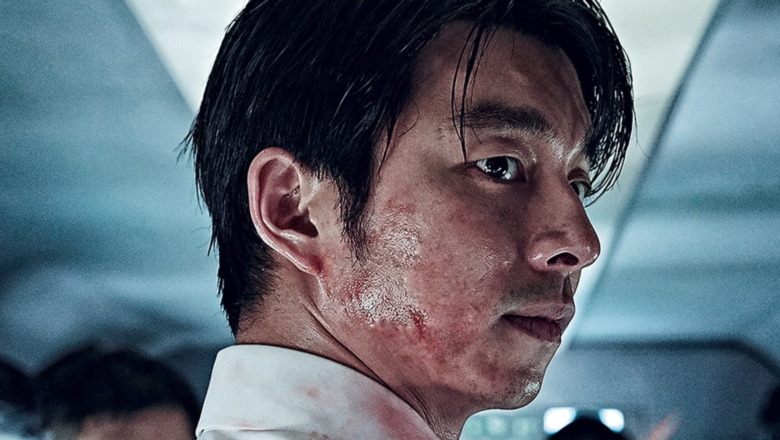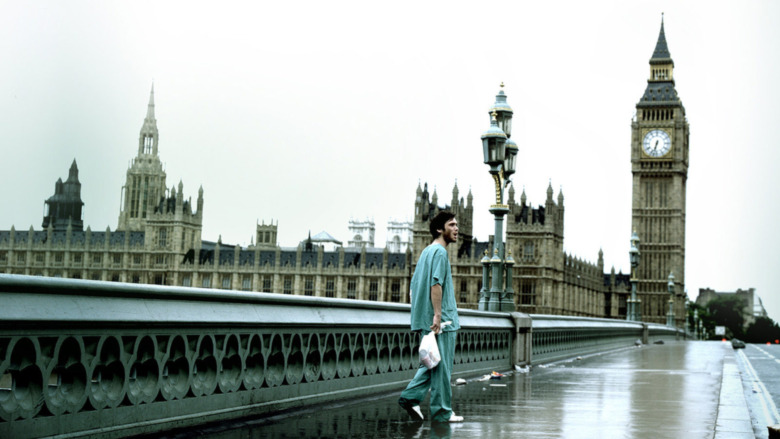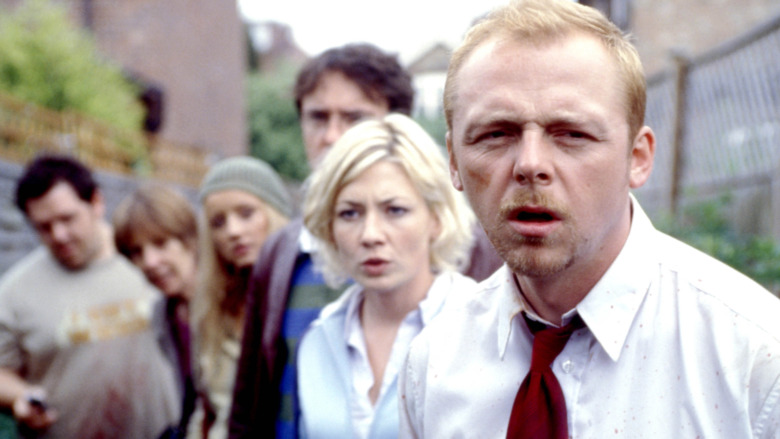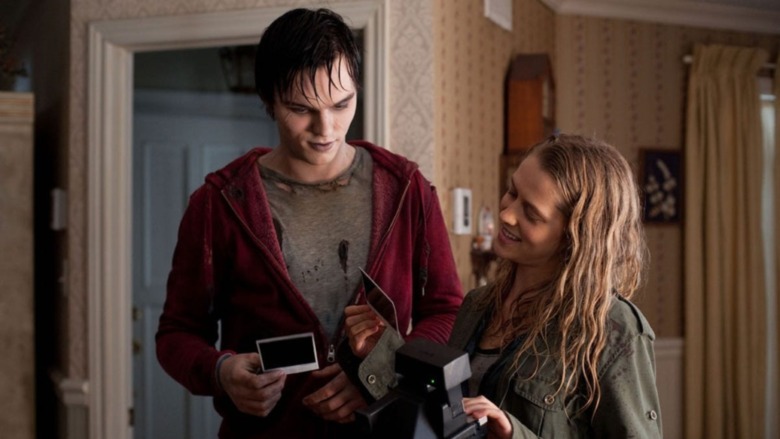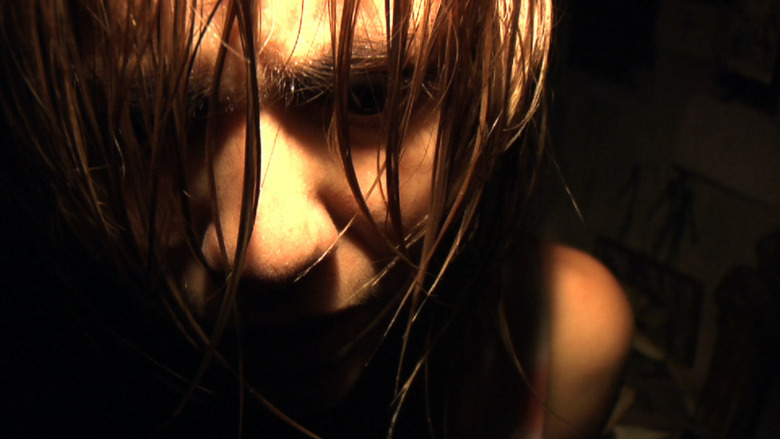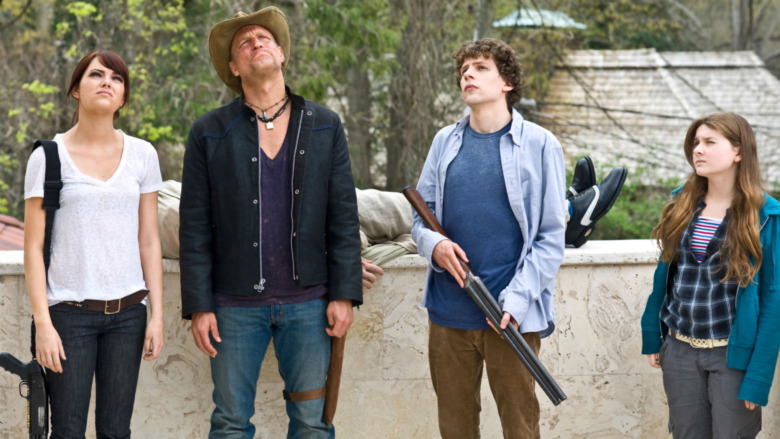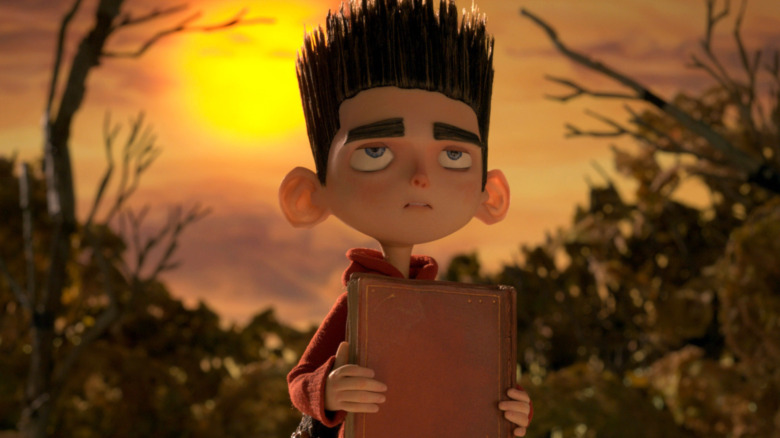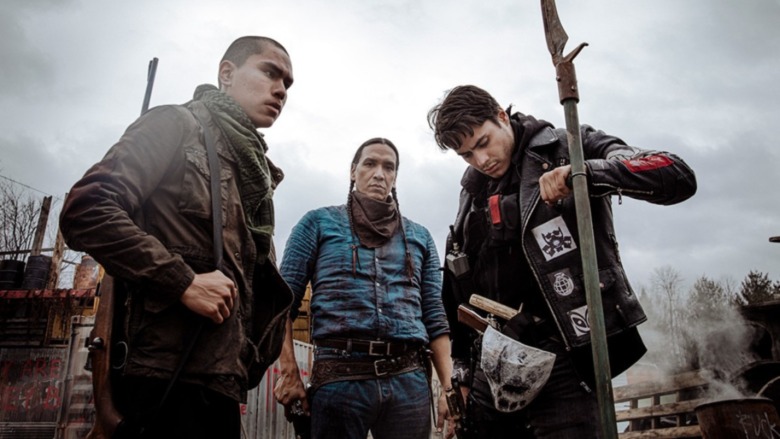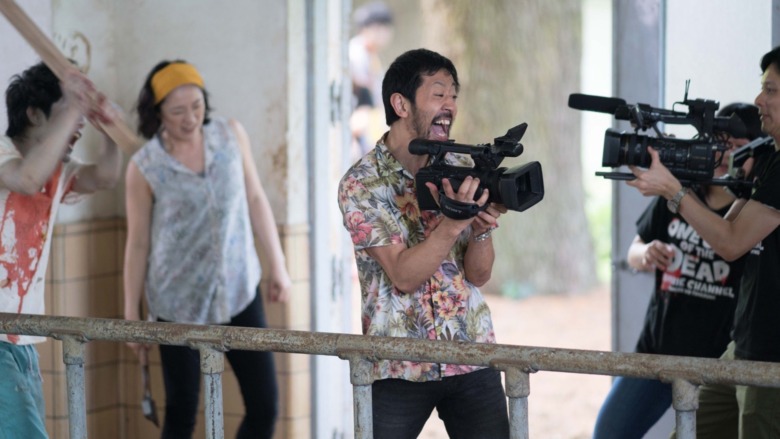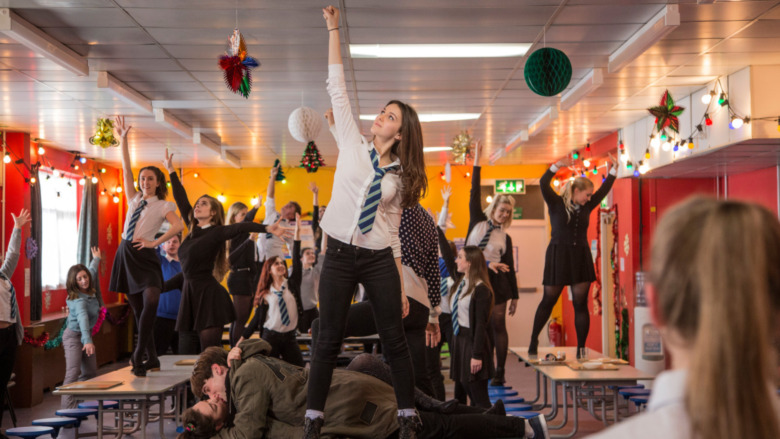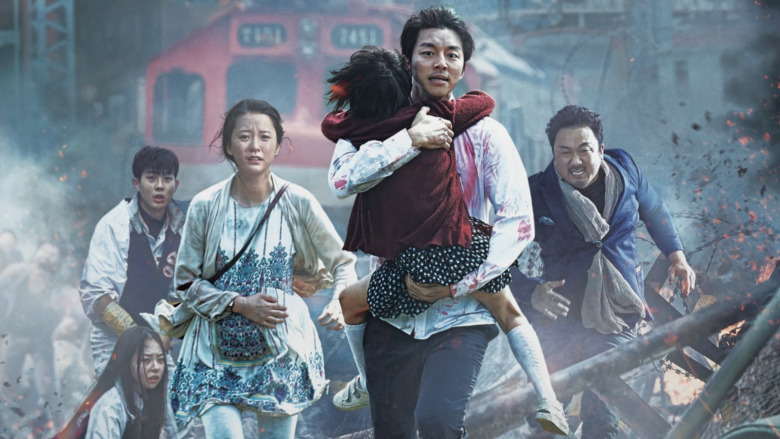The Best Zombie Movies Of The 21st Century
Ever since George A. Romero's trailblazing feature "Night of the Living Dead" hit theater screens in the 1968, zombie movies have become a regular fixture of the horror genre all around the world. Their persistent presence in cinema can be chalked up to how easy it is to plop these creatures into so many different formats. Not only can zombies inhabit a wide variety of genres (sci-fi, comedy, action), but they can also represent many different real-world struggles. This helps to make these undead entities eternally relevant in cinema. Plus, the undeniably gnarly visual appearance of zombies also makes them just flat-out fun to watch in films.
If you're especially fond of zombies, you've had no shortage of options for great zombie films in the 21st century, as the pop culture landscape has been soaked in stories involving the undead. These range from light-hearted comedic takes on the genre to pulse-pounding stories guaranteed to keep you up at night. The very best zombie movies of the 21st century aren't just great films on their own terms, they're also reflections of why this strain of horror storytelling proves so enduringly enjoyable.
28 Days Later
Before he directed the Oscar-winning movie "Slumdog Millionaire," director Danny Boyle helmed a number of acclaimed offbeat British features like "Trainspotting" or "Shallow Grave." But the man really grabbed our attention with 2002's "28 Days Later." This feature had the brilliant storytelling stroke of starting one of these zombie movies in media res, with a man waking from a coma 28 days into a zombie apocalypse. Both the protagonist and the audience are thrust right into a world turned upside down, one that's full of relentless zombies (courtesy of a rage-inducing virus), as well as greedy human beings who can be even more monstrous than the infected.
Though Boyle would go on to direct restrained dramas like "Steve Jobs," with "28 Days Later," the filmmaker demonstrated an ability to do grisly horror that occurs at a breakneck speed. Even while handling such speedy and terrifying monsters, Boyle never forgot all the details that make the best zombie movies work. This especially comes through in the cinematography, which eschews a grand scope in favor of capturing this story in a manner as grimy as the post-apocalypse world the characters inhabit. Boyle's gift with working with actors also means that "28 Days Later" features a number of great lead performances from actors like Cillian Murphy, who anchor the proceedings in a distinctly human place. Even with all the impressive movies he's helmed, "28 Days Later" still remains one of Boyle's finest creations, as well as an essential movie for the 21st-century canon of zombie cinema.
Shaun of the Dead
For his second feature-length directorial effort (everybody forgets about "A Fistful of Fingers"), Edgar Wright partnered up with familiar creative companions Simon Pegg and Nick Frost for a genre they had relatively little experience with — zombie cinema. Making a comedic take on the monsters at the center of "Night of the Living Dead" wasn't exactly a novel concept, but "Shaun of the Dead" breathed new life into the proceedings through a variety of means.
Chief among these was Wright's energetic direction, which was intact from the very start of his career. The rapid-fire pace that informed the movie's funniest scenes (like the "grab a pint" montage) was a bolt from the blue for comedy filmmaking in this era, and it also lent the movie a unique atmosphere compared to other zombie-based comedies. Similarly, the commitment to a believable friendship between Pegg and Frost's characters stood out in a genre whose weakest entries tended to reduce human beings to merely disposable cannon fodder. There was also the fact that it was also simply hysterical, a movie where every line gets more and more humorous the more you sit on it.
Through these and other virtues, "Shaun of the Dead" proved to be the kind of comedy classic that scores a number of impressive achievements at once. Not only did "Shaun" kick off the "Cornetto Trilogy," it also established Wright as a filmmaker of note and set a new standard for zombie comedies. Not too shabby for a man who was basically brand new to directing motion pictures.
Warm Bodies
In the wake of "Twilight" turning romances involving vampires into money-printing machines, it was inevitable that someone would try the same teen-oriented trick with that other staple of horror movies — zombies. Such a story came to pass with 2013's "Warm Bodies." However, those expecting just another "Twilight" knock-off would be in for a surprise. Director Jonathan Levine ("50/50") was in charge of "Warm Bodies," and he imbued the film with a more endearing spirit than anyone could've expected.
Part of what made "Warm Bodies" work like it did was that it made no bones about being a story set in a zombie post-apocalypse. Rather than delivering "grounded" visions of what zombies would look and act like, "Warm Bodies" revels in its strange take on the classical versions of zombies — the ones that eat brains, move slow, and can barely speak. This results in a lot of fun comedy and some unexpectedly heartfelt moments in seeing one of these creatures fall head over heels for a human woman.
Plus, there's a welcome sincerity to how it tackles the central romance. The film actually wants you to get invested in a zombie/human relationship, not laugh at it. A totally committed lead performance from Nicholas Hoult punctuates the sense that the people behind "Warm Bodies" genuinely care about this story, and they deliver a movie romance that's a little off the beaten path. Forget being a "Twilight" knockoff, "Warm Bodies" ends up being the kind of imaginative movie that other films try to copy.
REC
In the late 2000s, nearly a decade after "The Blair Witch Project" brought found-footage into the mainstream, the genre saw a major resurgence. All kinds of horror films were using this format, from the low-budget supernatural thriller "Paranormal Activity" to the kaiju feature "Cloverfield." This trend wasn't limited just to America, though, as Spain delivered a unique spin on the zombie genre through the incredibly freaky "REC."
The film details a reporter who accompanies a group of firemen to an emergency at an apartment building where a zombie outbreak has begun. The chilling tale received acclaim for its fantastic use of the found-footage format. Rather than just using this filming style to justify constantly shaky camerawork, directors Jaume Balagueró and Paco Plaza used the found footage style to immerse audiences in a world of frightening uncertainty. The brazenly chilling imagery found throughout the movie also made sure that "REC" couldn't be mistaken for any other zombie flick.
These qualities and so much more helped to make "REC" so acclaimed that it not only became a box office success, it also spawned an American remake in the form of the 2008 motion picture "Quarantine." However, that title ended up impressing far fewer critics than the first Spanish film. More than a decade later, it's the original "REC" that's still keeping moviegoers up at night with its bold approach to found-footage filmmaking.
Zombieland
It's easy to see a version of "Zombieland" that's merely an American rehash of "Shaun of the Dead." After all, how many gags can you really do with people navigating a world littered with zombies? Luckily, this 2009 feature manages to establish its own identity by, among other things, leaning on a number of totally singular performances. Jesse Eisenberg's dorky everyman makes for a unique protagonist in the post-apocalypse movie canon that usually features lead characters who are total badasses like Mad Max. As for Woody Harrelson's Tallahassee, this no-BS tough guy is as humorously realized as his accent is thickly Southern. Emma Stone and Abigail Breslin round out the lead cast with their believable sisterly rapport, a dynamic not often explored in mainstream American zombie movie.
Such distinctively rendered characters are paired up with a number of other memorable flourishes under the assured direction of filmmaker Ruben Fleischer. These include on-screen text explaining rules to survive the zombie apocalypse and a great pay-off to a running gag about one character's fear of clowns. With this kind of commitment to idiosyncratic humor, "Zombieland" has had no trouble making audiences forget about other zombie comedies. And after scoring positive reviews in its initial release, "Zombieland" managed to create enough of an enduring fanbase that it got a sequel a decade after its release. Like the undead, "Zombieland" refuses to die, and it's no mystery why. Comedies as good as this one are rarer than a Twinkie in the apocalypse.
ParaNorman
Looking for a zombie movie to watch with the whole family? The options are scarce, but "ParaNorman" proves they're out there. The second film from Laika, "ParaNorman" is the story of Norman, a kid who can see ghosts. Weirder still, his town ends up getting invaded by Puritan zombies. The project isn't as intense as a Tobe Hooper movie, but it shouldn't surprise anyone familiar with other Laika titles like "Coraline" that "ParaNorman" refuses to sanitize its frights just because it's a PG-rated kids movie. The zombies here are actually menacing, not just machines to deliver pop culture references.
But the presence of zombies and ghosts in "ParaNorman" isn't just used to deliver a kid-friendly horror movie. The third act eventually reveals that these supernatural beings, as well as the ostracized Norman and his unusual abilities, are here to provide some insightful commentary on what society deems "monstrous." All of this is told through Laika's reliably impressive stop-motion animation, which lends a tactile quality to everything from a zombie's dangling jaw to askew nail polish. Through all these features, "ParaNorman" ends up being a movie that's equal parts chilling and thoughtful. Such a mixture has led to this being one of the more critically acclaimed animated movies of the last decade. This insightful take on the zombie genre is bound to impress viewers of all ages, but it could also be a great "gateway film" for young viewers with no experience in the world of zombie cinema.
Blood Quantum
Zombie movies have always been used as a means for providing social commentary. This trend has continued with the 2020 film "Blood Quantum." This feature deals with a zombie outbreak from a unique perspective — the residents of a First Nations reserve. Turns out, the inhabitants of this location are immune to the zombie virus that's eradicating humanity. It's still no picnic surviving the apocalypse, though, and the film's lead characters — including protagonist Traylor (Michael Greyeyes) — must survive a new zombie-inflicted status quo. All the while, the project offers ruminations on experiences specific to indigenous individuals, who rarely get to be treated as straightforward heroes in mainstream English-language genre movies.
The second feature-length film from director Jeff Barnaby, "Blood Quantum" received very positive marks from critics, with Roxana Hadadi from Pajiba praising the project for how it takes "aim at colonization and the subjugation of native and indigenous peoples, and [Barnaby is] wrapping those considerations in writhing coils of intestines and splattering them with a hot burst of arterial blood." This kind of praise was echoed by critics at large, and the combination of social commentary and blood-soaked carnage makes "Blood Quantum" more than just an entertaining thrill ride. It's also an exciting expansion on the kind of themes that zombie movies can explore.
One Cut of the Dead
"One Cut of the Dead" is a movie that earns the term "ingenious." Its structure is reliant on the element of surprise, but even without spoiling its big game, its easy to say that director Shin'ichirō Ueda shows real imagination in making something that works as a zombie movie and a commentary on show business.
The horror movie part of the equation involves a film crew who, during a break in shooting a zombie flick, are attacked by an actual group of zombies. It's an event chronicled in an extended one-take, hence the title. Like the best uses of this visual format, the film's refusal to cut away actually enhances the story and atmosphere rather than lapsing into something distracting. Specifically, starting the story with just the crew members chilling out before abruptly shifting to a grisly zombie invasion — without any cuts to provide a sense of transition — makes the sudden presence of the undead appropriately jarring.
Ueda does impressive work handling this tonal shift from a casual hangout vibe to all hell breaking loose. But the pulse-pounding POV of the film crew isn't all this film offers. Later on, Ueda provides viewers a whole new perspective of this carnage that gives surprising layers of meaning to seemingly throwaway moments from earlier in the movie. At once a rollercoaster ride and an exercise in unearthing depth in unexpected places, the sense of creativity in "One Cut of the Dead" is very much alive!
Anna and the Apocalypse
Musicals and zombies. Putting those two together already sounds like a recipe for a tonally skewed mess. Throw in the trappings of a Christmas movie on top, and your film begins to sound like a mish-mash of genres randomly drawn out of a hat. Happily, "Anna and the Apocalypse", which brazenly belongs to all three subgenres, is actually quite a delight.
Part of why this tale — concerning Anna as she and her high school friends try to navigate the sudden presence of a zombie apocalypse — works so well is that it doesn't give the short thrift to any of the genres it's covering. The Christmas setting isn't just set dressing. Instead, it actually informs various storylines involving troubled family dynamics. Ditto the zombies, who are actually menacing creatures rather than just toothless renditions of these monsters. As for the musical numbers, they're extremely well-written ditties that, unlike many modern musical movies, aren't ashamed to be over-the-top tunes. The cherry on top for these musical numbers is they're delivered through lively choreography and cogent camerawork.
"Anna and the Apocalypse" isn't smashing disparate genres to make some belabored punchline, and its affection for all of these types of storytelling is both apparent and endearing. Like so many culinary treats, "Anna and the Apocalypse" is what happens when you get something magical out of fusing together things that shouldn't be paired up.
Train to Busan
"Zombies on a train" may sound like a premise conjured up as some kind of circa. 2006 attempt to cash in on "Snakes on a Plane," but that's the central conceit behind "Train to Busan," one of the greatest zombie movies ... of the 21st century or otherwise. Writer Park Joo-suk and director Yeon Sang-ho trap a whole bunch of characters, including a fractured father and daughter, into the cramped confines of a train that suddenly becomes packed with zombies. This turns out to be an ideal location for staging intensely suspenseful set pieces.
"Train to Busan" will give any zombie lover their fill of the undead chowing down on human flesh, but what really makes this script special is how it never sacrifices the humanity of its living protagonists. The characters in "Train to Busan" aren't just meat, they're people you can relate to. This is especially true of Ma Dong-seok's Yoon Sang-hwa, a charismatic tough guy with a heart of gold. Though Dong-seok is the highlight of the cast, there's really no shortage of memorable performances here that lend such impressive specificity to the various train passengers. With such engaging figures to ground the story, "Train to Busan" gets the audience to cry rather than cheer when humans get mowed down by zombies. Who knew the combination to creating a flawless zombie movie was simply merging these creatures with trains?
